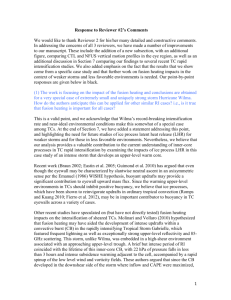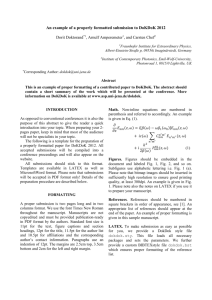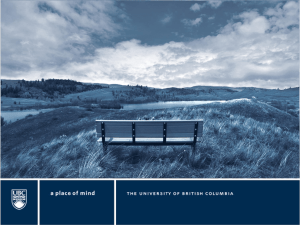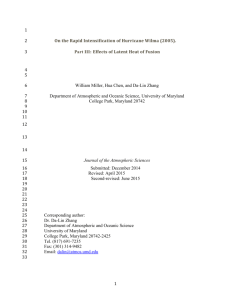Rev1_response_06Apr - Atmospheric and Oceanic Science
advertisement
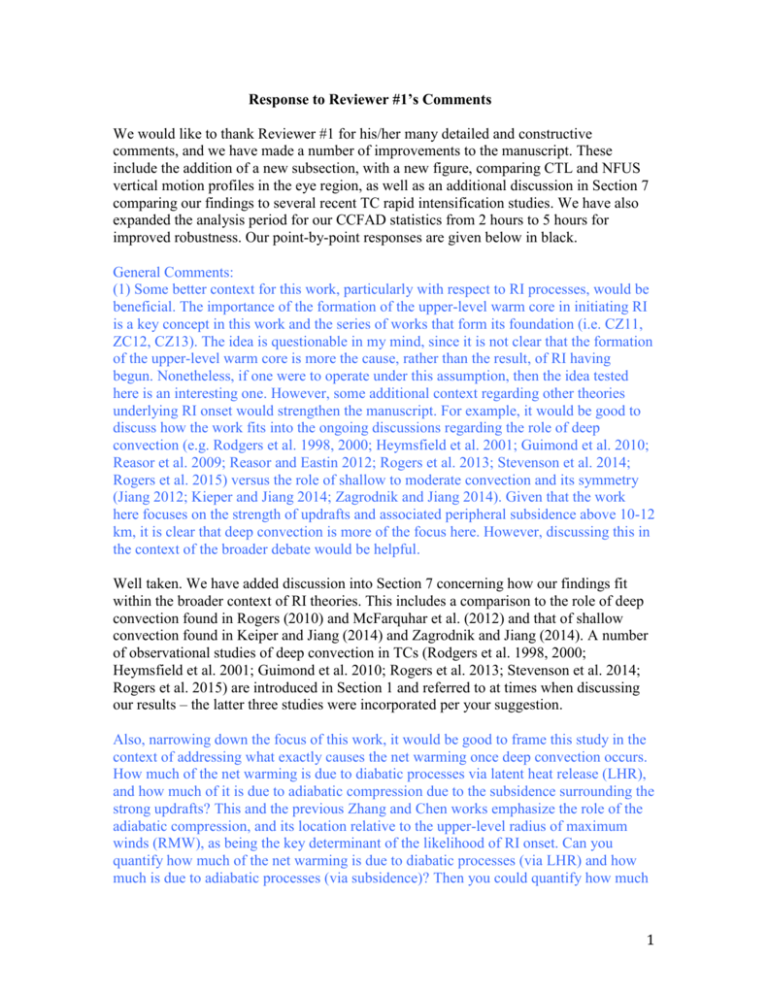
Response to Reviewer #1’s Comments We would like to thank Reviewer #1 for his/her many detailed and constructive comments, and we have made a number of improvements to the manuscript. These include the addition of a new subsection, with a new figure, comparing CTL and NFUS vertical motion profiles in the eye region, as well as an additional discussion in Section 7 comparing our findings to several recent TC rapid intensification studies. We have also expanded the analysis period for our CCFAD statistics from 2 hours to 5 hours for improved robustness. Our point-by-point responses are given below in black. General Comments: (1) Some better context for this work, particularly with respect to RI processes, would be beneficial. The importance of the formation of the upper-level warm core in initiating RI is a key concept in this work and the series of works that form its foundation (i.e. CZ11, ZC12, CZ13). The idea is questionable in my mind, since it is not clear that the formation of the upper-level warm core is more the cause, rather than the result, of RI having begun. Nonetheless, if one were to operate under this assumption, then the idea tested here is an interesting one. However, some additional context regarding other theories underlying RI onset would strengthen the manuscript. For example, it would be good to discuss how the work fits into the ongoing discussions regarding the role of deep convection (e.g. Rodgers et al. 1998, 2000; Heymsfield et al. 2001; Guimond et al. 2010; Reasor et al. 2009; Reasor and Eastin 2012; Rogers et al. 2013; Stevenson et al. 2014; Rogers et al. 2015) versus the role of shallow to moderate convection and its symmetry (Jiang 2012; Kieper and Jiang 2014; Zagrodnik and Jiang 2014). Given that the work here focuses on the strength of updrafts and associated peripheral subsidence above 10-12 km, it is clear that deep convection is more of the focus here. However, discussing this in the context of the broader debate would be helpful. Well taken. We have added discussion into Section 7 concerning how our findings fit within the broader context of RI theories. This includes a comparison to the role of deep convection found in Rogers (2010) and McFarquhar et al. (2012) and that of shallow convection found in Keiper and Jiang (2014) and Zagrodnik and Jiang (2014). A number of observational studies of deep convection in TCs (Rodgers et al. 1998, 2000; Heymsfield et al. 2001; Guimond et al. 2010; Rogers et al. 2013; Stevenson et al. 2014; Rogers et al. 2015) are introduced in Section 1 and referred to at times when discussing our results – the latter three studies were incorporated per your suggestion. Also, narrowing down the focus of this work, it would be good to frame this study in the context of addressing what exactly causes the net warming once deep convection occurs. How much of the net warming is due to diabatic processes via latent heat release (LHR), and how much of it is due to adiabatic compression due to the subsidence surrounding the strong updrafts? This and the previous Zhang and Chen works emphasize the role of the adiabatic compression, and its location relative to the upper-level radius of maximum winds (RMW), as being the key determinant of the likelihood of RI onset. Can you quantify how much of the net warming is due to diabatic processes (via LHR) and how much is due to adiabatic processes (via subsidence)? Then you could quantify how much 1 the changes you made to the LHR via removal of fusion heating contributes to the partitioning between net warming due to diabatic vs. adiabatic processes. We understand your concerns. To address your concerns, we have performed a heat budget analysis for CTL using 5 min temporal resolution data, shown below in Figure A. This time series shows tendencies of the individual terms in the potential temperature 𝜕𝜃 equation (D/Dt = 𝜕𝑡 + HADV + VADV, with HADV and VADV being the horizontal and vertical advection terms, respectively) averaged over a control volume centered on the upper-level warm anomaly. Our analysis shows that adiabatic subsidence warming is the primary contributor to positive local tendencies in the control volume. As expected, the time-varying intensities of local warming and volume-averaged subsidence are correlated. Horizontal advections contribute little to the warming. The green curve, D/Dt, which includes both errors and contributions from diabatic heating, diffusion, and other forcings, generally remains quite small (nearly an order of magnitude less) relative to the local tendency. These results are also consistent with the eye heat budget analyses shown in Zhang et al. (2002), Stern and Zhang (2013), and Ohno and Satoh (2015), both in the magnitude of the local tendency and in the lack of significant forcing term contributions away from the eyewall interface region. This warming in the inner portion of the eye, away from the eyewall interface, should be most significant in hydrostatically inducing surface pressure falls because it is located directly above the storm center. We have repeated our heat budget analysis on a larger control volume, shown in Figure B. Here the forcing term becomes somewhat more substantial, especially after 24:00, which makes sense to us, given the closer proximity of the control volume to the eyewall interface in the contracting eye. In the outer parts of the eye we would expect enhanced negative contributions from evaporative/sublimative cooling due to hydrometeors being detrained from the eyewall. The horizontal advection also increases, possibly as a result of eddy processes or influences from the main outflow. Nevertheless, here in the expanded control volume, subsidence warming is the only budget term contributing positively toward the local tendency throughout RI. 2 Figure A. Time series for CTL comparing the terms of the potential temperature tendency equation averaged over a control volume 10 km × 10 km square, z = 12-16 km, centered on the PMIN centroid. Curves show data that has been smoothed into a 1-hour running mean, with equal weighting applied to the 30-minute periods prior to and after the indicated time. Figure B. As in Figure A, but for an expanded control volume, 16 km × 16 km, z = 12-16 km. 3 To compare eye subsidence between CTL and NFUS, we have added a new figure to the manuscript, Fig. 9, given here as Fig. C. The times correspond to those examined in Fig. 8 for eyewall vertical motion, with data composited from 5 h time windows (11 timesteps total at 30 min resolution) centered on the indicated forecast hour. Although CCFADs taken from the RI period (left panels) show both the CTL and NFUS eye regions to be characterized by peak updrafts and downdrafts of 1-3 m s-1 through a deep layer, which contrasts with the conventional view of a TC eye characterized by weak downward motion, profiles of w averaged over the eye area and 5 h analysis window (right panels) reveal subsidence through a deep layer for both. In the early RI period, note the 10-12 cm s-1 mean subsidence above z = 12 km for CTL, at altitudes near and above the developing warm core (Fig. Cb). NFUS, in contrast, shows weaker subsidence of 4-7 cm s-1 peaking several km lower at this time (Fig. Cb). We compare these differences in eye subsidence to eyewall updrafts at the same time shown in Fig. 8a, given here as Fig. Da (which we have also revised to include a larger 5 h window of composited data, per minor comment #21 below). It is evident that for CTL, stronger peak eyewall updrafts near the tropopause are coinciding with stronger upper-level mean eye subsidence, particularly above z = 14 km. By time of peak VMAX (Fig. Cd) CTL has developed even stronger deep-layer eye subsidence relative to NFUS, and this may be reflecting the mass response to vortex-scale processes associated with the storm intensification (Zhang et al. 2000). We provide further discussion of these results in Section 5/Subsection (b) of the manuscript. Figure C. Left panels: CCFAD of w as in Fig. D but for the eye region (6 km × 6 km box surrounding storm center). Right panels: area-averaged mean vertical motion (green for 6 km × 6 km box, orange for 10 km × 10 km box) and areal fraction of subsidence (w < 0 m s -1; blue for 6 km × 6 km box, purple for 10 km × 10 km box); CTL/solid, NFUS/dotted. 4 Figure D. Left panels: CCFAD of vertical motion for the eyewall, showing the percentage of gridpoints in the horizontal plane with vertical motion magnitudes greater than the abscissa-marked scale. Updrafts are shaded in orange for CTL and contoured in black for NFUS. Downdrafts are shaded in blue for CTL and contoured in green for NFUS, following the same percentage intervals but with only the outer three lines labeled. Right panels: eyewall area-averaged upward (w > 0 m s-1, red) and downward (w < 0 m s-1, blue) vertical motion profiles with areal fraction of updraft core elements (w ≥ 1 m s -1, black) and downdraft core elements (w ≤ -1 m s-1, gray); CTL/solid, NFUS/dotted. Top row shows 20:00 CTL/24:00 NFUS, and bottom row shows 32:30 CTL/39:00 NFUS. *Note that for Figs. C and D, faint negative signs might appear near the downdraft labels in the color bar for some magnification settings of this document. This is an artifact of the fact that the downdraft percentiles were recorded as negative numbers in the data file, and when plotting the data using GrADS, the negative signs were manually blanked out. These lines do no appear in the corresponding .eps files which we are uploading as NonRendered figures. 2) The manuscript would benefit from considering additional works not listed here, some of which nicely support the conclusions drawn here. On the modeling side, work on the convective-scale structure and evolution before and during RI was also shown in Rogers (2010) and McFarquhar et al. (2012). Using CFADs and CCFADs, these papers included discussion (and sometimes contradictory conclusions) on the relative importance of strong vs. moderate updrafts, the evolution of the height of the peak updrafts, and the evolution of the upper-level subsidence near the developing eye for rapidly-intensifying Hurricane Dennis. Observations of the role of deep convection (and convective bursts, 5 CB’s) from aircraft and lightning data in RI events were also shown in Reasor et al. (2009), Reasor and Eastin (2012), Rogers et al. (2013), Stevenson et al. (2014), and Rogers et al. (2015). Rogers et al. (2013) showed composites using airborne Doppler data from a multitude of cases. They looked at CCFAD profiles of eyewall vertical velocity for intensifying and steady-state cases, and found stronger updrafts at the extreme end of the vertical velocity spectrum for intensifying rather than steady-state cases. These differences were primarily manifested above ~5 km, i.e. above the freezing level. While not explicitly stated in their work, the implication is that there are more ice-phase processes occurring for intensifying cases. This appears to provide direct observational support for what you are testing here. Good points. We have incorporated references to several additional observational and modeling studies that analyzed the role of deep convection/CBs in the RI process (see response to General Comment #1 above). In our analysis of eyewall vertical motion (Section 5/subsection a) we added a specific comparison to the CCFAD shown as Fig. 12 in Rogers et al. (2013), since that figure directly supports our results. 3) Some of the discussion in the manuscript is confusing to me. For example, the authors discuss how CB’s occur in a slantwise neutral environment, yet the bursts routinely produce updrafts stronger than 20 m/s. Is there a time-scale issue here? For example, perhaps over long time scales the environment is slantwise neutral, but on the time scale of individual CB’s there are areas of significant instability. That was discussed on some level, but if that is the case it would be good to clarify that apparent paradox. Also, the authors discuss how ice-phase processes cause CB’s. This seems to have the direction of causality backwards, since ice-phase processes don’t cause CB’s. Rather, CB’s, and the vigorous updrafts that accompany them, can cause the suspension of supercooled water over a deep layer that can result in freezing and LHR there. Well taken. We have clarified our discussion in Section 6 regarding the apparent paradox between the slantwise neutral soundings and apparent buoyancy in the selected CBs, as shown by the intense updrafts (w ≥ 15 m s-1) and non-negligible SCAPE. We identify two possible explanations for this paradox. First, since our soundings are constructed from an Eulerian, rather than parcel-following, analysis framework, they could be showing the effects of convective overturning on short timescales that could rapidly eliminate any preexisting conditional instability. So we agree with your interpretation of there being a time-scale issue. Second, including ice process LHR in parcel temperature calculations (which we did for the CTL SCAPE calculations) can generate positive buoyancy in soundings which would be otherwise slantwise neutral to pseudoadiabatic ascent. In response to the second part of your comment regarding the “cause-and-effect” relationship between ice processes and CBs, we agree with you that ice LHR can only enhance updraft strength above the freezing level once preexisting strong updrafts are already present that can loft sufficient amounts of supercooled water. However, our definition of CBs (w ≥ 15 m s-1 for z ≥ 11 km) applies to a very specific subset of convective updrafts, those which we believe are most instrumental in inducing subsidence near the tropopause. This contrasts with other definitions of CBs in previous 6 studies which have emphasized updraft continuity through a deep layer, such as those used in Reasor et al. (2009) and Rogers et al. (2010): 2-6 km layer averaged w > 5 m s-1 and 700 hPa – 300 hPa layer averaged w > 5 m s-1, respectively. Because we are only focusing on the most intense updrafts at the highest levels, we believe that we can still use the phrase “ice processes generate CBs,” as it is our contention that maintenance/reinvigoration of updrafts at these levels is strongly dependent on ice process LHR, and we show a significant reduction in CB counts for the NFUS experiment. We understand, though, that we need to be careful not to be too quick in assigning causation. We use the more conservative phrase “(ice LHR) enhances CB activity” several times in the manuscript. Additionally, at the end of Section 7 we have a statement outlining the need for a better understanding of the relative roles of surface heat fluxes (which should generate the roots of these updrafts) and ice process LHR in enhancing deep eyewall convection. Minor comments 1) line 76: “?found deep mesoscale subsidence?” Suggest removing “a”. suggested. Done as 2) line 98: “?consistent with the work of Hack and Schubert (1986)?” The mechanism discussed in Hack and Schubert is different that what you propose. Those studies emphasized the direct effect of diabatic heating on warming the column through diabatic processes that result in a net warming once geostrophic, or gradient, adjustment has occurred. You discuss warming at different altitudes by subsidence warming. While both sources have heating that may be (at least partially) lost to gravity wave propagation, the amount lost is likely different. We agree that the Hack and Schubert (1986) analysis does not directly apply to Wilma because they were using a balanced, axisymmetric model, and because they were investigating diabatic heating impacts on the primary circulation spinup through column warming in the context of CISK theory. However, we believe that their concepts of dynamic efficiency 𝜂(𝑟, 𝑧, 𝑡) and system efficiency ̅̅̅̅̅̅ 𝜂(𝑡) with respect to the conversion of diabatic heating to kinetic energy can also be extended to our analysis, since subsidence warming is the mechanism by which Wilma’s eyewall LHR is converted to upper-level warming in the eye, and ultimately, to the primary circulation spinup through pressure falls. They found that the dynamic efficiency fields were maximized inside of the radius of maximum winds (RMW) and that moving the diabatic heat source to larger radii decreased the intensity of the system spinup since this moved it away from the region of maximized dynamic efficiency. Thus, this work provides a theoretical foundation for our decision to focus on CB activity inside of the upper-level RMW. 3) line 110: “?we hypothesize that LHR from deposition helps account for the development of CBs and that its occurrence within the RMW is the key to the RI of TCs?” Rogers et al. (2013, 2015) provide a very similar argument about the location of CB’s relative to the RMW using aircraft data. Also, the direction of causation in the “helps account for the development of CBs” appears to be backwards here (see major comments above). 7 We added references to Rogers et al. (2013, 2015) to this discussion since they provide observational support. We believe that the phrasing “helps account for the development of CBs” can be left as is, given our CB definition focuses on the most intense updrafts above z = 11 km, and because the phrase assigns only partial causation to the ice processes. 4) line 118: “?impact of upper-level depositional LHR on changes to TC structure and intensity?” The phrasing of this objective appears to invert the direction of causation as well. The hypothesis that we are testing here is the ability of depositional LHR to impact storm structure and intensity through CB compensating subsidence, so we feel that this phrase can be kept as-is. We acknowledge your point that ice LHR also depends in turn on the evolution of the storm structure, which generates the updrafts from below. Still, any differences in the NFUS storm structure evolution should ultimately depend on the latent heating differences from CTL, since we found the environmental conditions to be nearly identical between the two model runs. 5) line 146: “A parcel-following?(Fierro et al. 2012).” This is a run-on sentence. Suggest splitting it in two. Done as suggested. 6) line 160: “To study the impacts of depositional LHR?” By removing the component of latent heating from fusion heating (i.e. Lf), aren’t you really testing the impacts of fusion heating specifically, rather than the broader category of deposition (Lv + Lf)? Fusion heating (Lf) appears both in freezing processes (liquid-to-ice) and depositional processes (vapor-to-ice). For this study, we wish to analyze the heating associated with deposition, because we hypothesize that it may be more significant to high-altitude buoyancy in CBs since it occurs wherever vapor is supersaturated (with respect to ice) in the presence of frozen hydrometeors. Therefore we expect that this heating source should be spread throughout a higher altitude range above the freezing level, unlike freezing process heating, which has been shown (in one case study of tropical oceanic convection) to be confined to a shallower layer above the freezing level, due to the rapid depletion of supercooled water at higher altitudes (Fierro et al. 2012). For the NFUS experiment we remove the Lf component from the latent heat of deposition but leave Lf unchanged for freezing processes. Also, how common is deposition relative to freezing? What conditions produce deposition (I’m assuming strong updrafts)? What fraction of grid points experiences deposition? In the Thompson microphysics scheme (Thompson et al. 2008), deposition transfers water vapor mass to cloud ice, snow, or graupel wherever any of these hydrometeors 8 exist in the presence of supersaturated water vapor. It also includes the “ice nucleation” process whereby cloud ice crystals are generated from vapor using the Cooper (1986) curve. For ice nucleation to occur, either the water vapor supersaturation must exceed 25%, or water vapor must be at least saturated with T < 260 K. We cannot definitively determine what fraction of gridpoints deposition is occurring in, since the WRF model output does not provide us with any gridded information about specific microphysical mass transfer processes. However, we suspect that it may peak in the upper parts of convective updraft cores. According to Thompson et al. (2008), deposition is the only mechanism by which cloud ice grows in size. Once cloud ice particle size reaches 200 𝜇m it transfers to the snow category. Snow can grow by other processes, including aggregation or riming (a freezing process) besides deposition. In Figure E below, we re-plot Figure 4c from the manuscript (removing the downdrafts to improve visual clarity), but now we show how the individual frozen hydrometeor species (cloud ice, snow and graupel) are distributed with respect to the updraft core. We can see that cloud ice stays confined to the upper portion of the updraft core (z = 10-15 km layer), while snow is advected outward by the main outflow and graupel remains most abundant in the middle portion, just above the freezing level, where supercooled water is concentrated. Although cloud ice is roughly 100 times less abundant than the other hydrometeors, it should be a significant contributor to depositional heating since it grows by deposition only. Therefore, although deposition should occur in the middle portions of the updraft core above the freezing level in the presence of substantial graupel, and also in the main outflow branch due to the sizeable snow concentrations there, we believe that it may be maximized in the upper portion of the updraft core near the peak cloud ice and snow mixing ratios (z = 11-13 km). 9 Figure E. Cloud ice (shaded, 105 kg/kg) with snow (dotted black contours, 0.5/2/4 g/kg) and graupel (orange contours, 0.5/2/4 g/kg). Gray contours show positive w (1/3/6/9 m s -1) and light blue contour marks the freezing level. For in-plane flow vectors, vertical motions are multiplied by 3. Azimuthally-averaged variables are taken from CTL/32:30. Your sensitivity test is excluding LH of freezing from the calculation of deposition. So isn’t this really testing the impact of freezing only when deposition is occurring? Yes, we are removing fusion heating (Lf) only when deposition is occurring. The process we are studying is deposition, and we test it by removing the Lf component to the latent heat of deposition Ld. We are not testing the impacts of the freezing (water-to-ice) processes because for NFUS we have left Lf alone in the temperature tendencies caused by them. 7) line 204: “?descend at RI onset?commencing a period of increased upper-level warming.” Instead of commencing, do you mean to say “indicating”? Using the word “commencing” seems to imply causation. Agreed – “indicating” is a better word choice here, fixed. 8) p. 9, footnote: “?thus causing less CB elements?” Replace “less” with “fewer”. 9) line 238: “tilted updraft core” Prefer using term “sloped”. Both fixed as suggested. 10 10) line 273: “Meanwhile, a reduction in static stability?” Where is that reduction occurring? If it’s within the core of the warm anomaly, I could see a reduction in the static stability as isentropes spread apart in the vertical. Below the warm anomaly, the isentropes are closer together, and the stability increases. We changed the wording to indicate that we are referring here to the core of the warm anomaly. This reduction was shown for CTL following RI onset in Chen and Zhang (2013) Fig. 1c. 11) Line 279: “?CB activity inside the?z=11-km RMW.” Rogers et al. (2015) discuss the relationship between the radial location of CB activity relative to the lower-level (2-km) and upper-level (8-km) RMW, based on airborne Doppler measurements in Hurricane Earl (2010). The Rogers et al. (2015) results showing updraft cores (and CB activity) to remain inside the RMW axis for rapidly intensifying Earl, unlike for the non-intensifying Gustav are interesting and support our contention that local convective instability, which may cause the updraft cores to be more upright in the intensifying cases, is important to TC intensification. We added a reference to the Rogers et al. (2015) results to our Introduction. However, we are not sure whether such shear-induced effects, which were seen on the downshear side of Earl, would occur in Wilma due to the very low VWS (< 5 m s-1, Chen and Zhang 2013, p. 153) experienced during RI. 12) line 294: “Figure 6 compares histograms of maximum vertical velocity?” How did you calculate this? Did you track specific updrafts, or is this more of an Eulerian calculation? It would be preferable to be able to track specific updrafts. We did not track specific updrafts, so yes, this is more of an Eulerian calculation. We searched grid columns inside the azimuthally-averaged z = 11-km RMW for any gridpoints with w ≥ 15 m s-1. We did not impose the z ≥ 11 km requirement, so therefore we were not strictly counting CBs (by our definition). For each selected grid column, we flagged the height where vertical motion peaked, and then constructed a histogram of updraft numbers (i.e. number of grid columns with w ≥ 15 m s-1) binned by peak w height. The updraft numbers shown are the total counted per period (pre-RI, RI, and postRI) divided by the number of timesteps in that period, thus giving the average number per timestep during the period of interest. 13) line 317: “?parcel buoyancy is calculated along slantwise trajectories following constant ?(AAM) surfaces?” What about the potential for updrafts to depart from the AAM surface? Hazelton et al. (2015) and Rogers et al. (2015) show examples where the updraft core is more upright than the AAM surface. Hazelton et al. (2015) show that this is a distinguishing characteristic of intensifying (as opposed to steady-state) storms. We understand that assuming that the updrafts follow AAM surfaces is an oversimplification. In our SCAPE calculations, we are seeking a rough estimate of azimuthally-averaged conditional instability available in the eyewall. Still, we believe 11 that SCAPE is a much better indicator of available buoyancy than ordinary CAPE for eyewall convection. We did check the Hazelton et al. (2015) study and it appears as though their findings were confined to the downshear quadrants only for a sample of TCs with a median shear of ~7 m s-1. Given that Wilma was in a low-shear (< 5 m s-1) environment throughout its RI, we are not sure how applicable those findings might be to Wilma. Additionally, any shear-induced asymmetries in updraft core tilt might be largely erased when examining conditional instability in the azimuthal average, as we did for manuscript Fig. 7. 14) line 362: “?the 95th updraft percentile exceeding 5 m/s?” Should also compare these results with Fig. 12 from Rogers et al. (2013). In our discussion of the eyewall CCFADs we added a reference to this figure. We believe that it supports our findings. 15) line 388: “?strongest updrafts on the most intense 5% of updrafts above z=10 km.” Again, this is broadly consistent with Rogers et al. (2013), though the differences there were evident above z=6 km rather than 10 km. We agree. This may be a result of our isolating the impacts of deposition, rather than all ice processes (freezing + deposition). We believe that deposition has a larger impact on the upper portion of the eyewall updrafts (see response to Minor Comment #6 above). Yet at time of peak intensity (manuscript Fig. 8c/Fig. Dc above), the differences in the highest percentiles extend through a much deeper layer, becoming pronounced above z = 5 km. This suggests to us that the latent heat of deposition can impact updraft strength in areas just above the freezing level too. Why the differences between CTL and NFUS updraft CCFADs extend through a deeper layer by the later time step is not fully clear to us, but one possibility that we raise in our discussion is that even though CTL and NFUS develop warmer upper-level inner-core environments throughout RI, these effects are more detrimental to NFUS parcel buoyancy because of the reduced Ld. In Fig. F below, we compare the CTL and NFUS updraft cores at one of the timesteps used to construct the manuscript Fig. 8c CCFAD. (This is Fig. 4 from the manuscript reproduced but with total frozen hydrometeors replaced with graupel only.) One can see that even though CTL has greater peak upper-level warming, these differences are confined to the eye region (Fig. Fa,b). The entire NFUS updraft core passes through temperature anomalies (T’(z)) greater than 6° C above z = 8 km. In contrast, the outer portion of the CTL updraft core below z = 11 km passes through a comparatively cooler environment outside of the T’(z) = 6° C contour. What about hydrometeor loading effects? McFarquhar et al. (2012) also found (using CCFAD analysis), during the course of Dennis’s RI, a weakening of the highest percentile updrafts, and they attributed this effect to increased hydrometeor loading. However, the NFUS updraft core shows significantly lower graupel mixing ratios (Fig. Fc,d), so we do not believe that hydrometeor loading is the cause for the weaker NFUS strongest 95th percentile updrafts (relative to CTL) at peak intensity. We also compared the updraft core slopes (Fig. Fc,d) and even though the NFUS core appears to be slightly less upright in the upper portion, 12 this difference doesn’t appear large enough to account for the updraft strength differences. Figure F. Azimuthally averaged structures for (a, c) CTL at 32:30 and (b, d) NFUS at 39:00. Top row: T’(z) (shaded, K) with tangential winds (blue contours, m s-1), radial outflows (black contours, every 5 m s-1), and upper-level radial inflows (green contours, every 0.5 m s -1). Bottom row: graupel mixing ratio (shaded, g kg-1) with vertical motion (upward, gray contours, 1, 3, 6, 9 m s -1; downward, purple contours, -0.25, -0.5, -1 m s-1) and with the freezing level marked in light blue. For in-plane flow vectors (m s-1) in (a)-(d) vertical motions are multiplied by three. Green dashed lines in (c,d) show radial boundaries of the slanted eyewall defined in Section 5 at those times. For comparison, we also plot, in Fig. G below, azimuthally-averaged vertical motion, T’(z), and graupel mixing ratios for a representative timestep from the early RI stage CCFAD shown in Fig. 8a from the manuscript (Fig. Da above)-the CCFAD that you refer to in this comment. Consistent with the CCFAD, the CTL and NFUS updraft cores below z = 10 km are quite similar with respect to average vertical motion, surrounding T’(z) environment, and graupel concentrations. Note the different T’(z) color scales used here. Here we expect the difference in the 95th percentile updrafts to stem from mainly depositional LHR impacts on convective instability, rather than from any vortex evolution effects. 13 Figure G. As in Fig. F above, but for (a,c) CTL at 20:00 and for (b,d) NFUS at 24:00. Tangential winds are contoured in blue in (a,b): 20/30/40/50/60 m s-1, and updrafts are contoured in gray in (c,d): 1/3/6 m s-1. Downdrafts in (c,d) are contoured in purple on the same scale used for Fig. F. 16) line 397: “? Enhanced Ekman pumping processes?” Would Ekman pumping cause the strongest updrafts, or the more gentle upward motion? We believe that Ekman pumping could also be a cause for the strongest updrafts. However, after increasing the number of timesteps for the CCFAD calculations, NFUS now shows stronger low-level updraft outliers at the previous timestep (Fig. Da). The criteria that we used to define the eyewall CCFADs might not be capturing the entirely of the low level upward motion (z < 2 km) forming the roots of the updraft core near the base of the eyewall. This effect warrants further investigation, but since our focus here is on the upper levels, we decided to remove discussion of the Ekman pumping from the manuscript. 17) line 401: “? CB elements are no longer present.” In this sense CB’s are simply an arbitrary threshold (in this case > 15 m/s above z = 11 km). That is correct. We added emphasis in the text indicating that this is per our definition of CBs. 18) line 412: It is interesting that the moderate mean w profiles (50-75% level) show little difference early, but significant differences later. And those later differences are large even well below the freezing level. I would think that the most significant impact would 14 be where you have the most vigorous updrafts, which is (I presume) where you’d get most of the deposition. Perhaps the differences you’re seeing across w’s and altitudes at later times simply reflect the different evolutions of the two runs? Yes, we agree. Even though we kept the width of the eyewall annulus the same for both simulations at the early RI time (20:00 CTL/24:00 NFUS) and at the time of peak VMAX (32:30 CTL/39:00 NFUS), we had to expand the annulus with from 10 to 15 km to accommodate the larger CTL eyewall at the later time. Therefore, the increased differences in the 50-75% level should be at least partly a reflection of the smaller area of NFUS w > 0 m s-1 inside the region used to calculate probabilities (compare Figs. Fc,d with Gc,d above). The widening of the CTL eyewall happened after 27:00 as a result of the merger of a secondary eyewall, and this is shown in Chen and Zhang (2011) Figs. 11,12 and also in Fig. 7a in our manuscript. Also CTL has developed a stronger azimuthally-averaged secondary circulation by this time (Figs. Fc,d). 19) line 414: “Upper-level subsidence?” These differences are hard to see, which is a shame because this is a key point in your argument, i.e., in terms of the impact of upperlevel downdrafts on RI. We removed the discussion on upper-level downdrafts for the eyewall (which we admit are difficult to see) and added a new Subsection (b) to Section 5, with a new figure (Fig. 9), which focuses on the eye vertical motion. Here, differences in mean subsidence (averaged areally and temporally) are easier to see (see response to General Comment #2). The fact that the eye subsidence happens directly above the lowest surface pressure also strengthens our argument. 20) line 442: “?above z=12 km these differences become greatly reduced?” But you don’t see the impact of reduced peak updraft magnitude between the freezing level (~5 km) and 12 km. Why is that? Is it because you have a precipitation band on the southeast side of the storm in NFUS? That is right. We believe that the intense precipitation band on the southeast side for NFUS is the cause for its stronger convective updrafts below z = 12 km. By expanding the analysis time window from 2 h to 5 h, however, the differences below z = 12 km have become reduced. 21) p. 19, footnote: it would be good to calculate these statistics over more than a +/- 1 h period, to allow for evolution of the precipitation features. For example, you could try calculating the statistics over a 12-h window. It should produce the most robust statistics, though it might not eliminate the discrepancy of the stronger vertical velocity above 5 km. We increased the time window from 2 h to 5 h for all of our CCFAD and vertical motion profile calculations (manuscript Figs. 8-10). This has made our statistics more robust without using a time window so large that it might “smear out” some interesting features that evolve on vortex-scale time periods. Our results for the eyewall (manuscript Fig. 15 8/Fig. D here) changed little. The largest impact of this change was for the rainbands, with a reduction in the NFUS updraft strength at time of peak VMAX (39:00) below z = 12 km. Below our new outer rainband vertical motion plot, listed as Fig. 10 in the manuscript, is shown as Figure H. Figure H. As in Figure D but for the outer rainbands. 22) Line 471: “?the increased eyewall tilt?” I would replace “tilt” with “slope.” And the slope of what parameter? Vertical velocity? RMW? You are showing vertical velocity and reflectivity here. Finally the slope differences are not clear in c-d. In Figure I below, we plot radial-height cross sections for CTL and NFUS at this time (20:00 CTL/24:00 NFUS) averaged over the 180 azimuthal degrees containing the strongest CB activity (shown in manuscript Fig. 11). These cross sections show the spatial relationship between the updraft cores and frozen hydrometeor (ice + snow + graupel) fields. It appears as though the greater displacement between CB elements/updraft contours and peak column-integrated frozen hydrometeors in the northern NFUS eyewall, shown in Fig. 11 of the manuscript, results from a more sloped NFUS updraft core with respect to the vertical. Although we do not conduct a rigorous comparison, between CTL and NFUS, of the relative RMW and updraft core axis slope angles throughout RI (for wavenumber-0 and wavenumber-1 structures), if in fact the NFUS updraft core did tend to slope more steeply out of higher inertial stability regions, and this negatively impacted the NFUS intensification rate, this effect should be another consequence of the reduced LHR on the vortex evolution. Rogers et al. (2015) mentioned 16 reduced convective instability in non-intensifying storms as a possible cause of their less upright downshear updraft cores. Of course, we expect NFUS to have an overall weaker inertial stability field throughout RI due to its shallower, weaker primary circulation (Figs. F,G). Still, you raise a good point that we need to be careful when discussing eyewall slope, since the slope angles of the updraft and RMW axes may be different. We changed “tilt” to “slope,” per your recommendation. We also agree that the slope differences in c-d are not clear, and we removed mention from the text. Figure I. Radius-height cross section for (a) CTL and (b) NFUS of radar reflectivity (shaded, dBz), 𝜃𝑒 (black contours, K), vertical motion (upward, white contours, 1/3/6 m s -1, downward, dotted gray contours, -4/-3/-2/-1/-0.5 m s-1), and total frozen hydrometeors (cloud ice, snow, and graupel: magenta contours, g kg 1 ). For (a) the average is taken at 20:00 over a semicircle 25-205 degrees counterclockwise from due East. For (b) the average is taken at 24:00 over a semicircle 0-180 degrees counterclockwise from due East. 23) line 474: “upper-level ice LHR processes in the generation of CBs.” As mentioned previously, I don’t think ice LHR processes play a role in the generation of CB’s, but they certainly may play a role in the evolution of deep convection in terms of updraft/downdraft profiles, hydrometeor profiles, and LH release. We removed this sentence, since it essentially repeats the same statement made in Section 7. Since this statement refers to CBs more generally in the context of future studies, outside of the restrictive definition that we use, we changed the wording in the Section 7 statement to “future work is needed for better understanding the relative impacts of surface heat fluxes and ice LHR processes on CB updraft intensity.” 24) line 477: “?outwardly tilted updraft?” Change to “sloped”. suggested. Change made as 25) line 479: “layer descent of stratospheric origin?” Interestingly, upper-level subsidence is stronger along the inner edge of the updraft core in NFUS than it is in CTL, isn’t it? Though it does look like stronger peak updrafts with a higher peak altitude for CTL. 17 You are right-NFUS is showing stronger subsidence at this time, even though CTL has the stronger peak updrafts. Heymsfield et al. (2001) surmise that CB subsidence may be sporadic in nature, given that Bonnie’s “Hot Tower D” did not produce inward-directed subsidence detectable in the EDOP cross section, despite the fact that it was overshooting the tropopause by 2 km (their Fig. 10). Additionally, they mention the possibility that this CB may have been entering a dissipating stage. As shown in Chen and Zhang (2013), Wilma’s CBs have short (~30 min) lifecycles (their Fig. 5). Therefore, the time “snapshot” of the CBs shown in manuscript Fig. 11 may not be reflecting the peak subsidence for either one of them. Nevertheless, we show in our new Fig. 9 that over a 5 h time period centered on these times, CTL has stronger areally and temporally averaged subsidence in the upper portion of the eye. 26) line 503: “Substantial evidence for eyewall buoyancy on the convective scale exists?” I would think so, given that you’re producting > 20 m/s updrafts. This gets to one of my major comments. It appears that the discrepancy is rooted in differences in scale, i.e., on the fast-evolving convective scale, you can have significant buoyancy, whereas on the slower-evolving vortex scale, the net result of this convective overturning may be slantwise neutral ascent. Would you agree with this interpretation? Yes, we agree with your interpretation. We have clarified this discussion in the manuscript. 27) line 518: “Figs. 11b,d compare profiles of vertical motion?.” What about profiles of LHR? Also, I’m not sure how accurate this is, since you’re really looking at Lagrangiantype fields here, so you should follow updrafts, not just radial slices. We do not have output fields of LHR available from these WRF model runs. For this study we are using w as a proxy variable for LHR. With the gridded WRF output data that we have, accurate results following individual 15 m s-1 updrafts would be difficult to obtain. Since these CB updrafts are quite wide (for ocean convection, at least) we opted to perform the simpler Eulerian analysis here through the updraft cores, with the z-axis following their slope, which should give us a reasonable estimate of the hydrometeor fields, although our temperature fields are probably reflecting the influence of convective overturning, as we discuss in our response to General Comment #3 above. 28) line 535: “To illustrate how slantwise, as opposed to vertical?” What is the point of this comparison, other than just to compare the two? We are just trying to show how vertical TC eyewall soundings may not accurately reflect the thermodynamic environment traversed by rising parcels. 29) line 559: “CB elements inside the z=11-km?” You saw fewer CB elements in NFUS everywhere, not just inside the z=11-km RMW, didn’t you? Yes, that is correct. We also counted CBs within a 100 km radius of storm center and show the timeseries below as Figure J for (a) CTL and (b) NFUS (even though the y-axis 18 only shows radii out to 80 km). The differences between CTL and NFUS CB numbers are, if anything, even more pronounced. Figure J. Time series showing number of CB elements counted within 100 km of storm center (orange triangles) with average radius of CB occurrence (green crosses) for (a) CTL, and (b) NFUS. Mean z = 1-km and z = 11-km RMWs are shown as blue and black dots, respectively. Dashed vertical lines mark the beginning and end of the RI periods. 30) line 565: “?depositional heating appears to enhance updrafts?” The NFUS test is basically testing depositional heating, but without the fusion component, isn’t it? So what you’re saying here is that the addition of the fusion heating to the deposition term enhances updrafts and its associated subsidence. Yes that is correct. 31) line 575: “?ice LHR processes?generat(e) sufficient conditional instability to support CB updrafts in the eyewall.” But I thought you said it was neutral to slantwise moist ascent? Or are you saying that somehow the LH release from fusion is responsible for 19 generating buoyancy, allowing CB’s to occur even in the presence of apparent slantwise neutrality? Maybe this is the physical mechanism you’re trying to purport as underlying how ice processes “cause” CB’s. Is that a correct interpretation of what you’re saying? Yes that is a correct interpretation. The latent heat of fusion, which is released in depositional processes, generates the extra parcel heating that may allow local buoyancy to arise even when the sounding is slantwise neutral to pseudoadiabatic ascent. We refer to ice process LHR causing CBs since our definition of CBs is restricted to the tallest and strongest updrafts, whose existence depends on this conditional instability. References: Chen, H., D.-L. Zhang, J. Carton, and R. Atlas, 2011: On the rapid intensification of Hurricane Wilma (2005). Part I: Model prediction and structural changes. Wea. Forecasting, 26, 885-901. , and D.-L. Zhang, 2013: On the Rapid Intensification of Hurricane Wilma (2005). Part II: Convective bursts and the upper-level warm core. J. Atmos. Sci., 70, 146-162. Fierro, A. O., E. J. Zipser, M. A. LeMone, J. M. Straka, and J. Simpson, 2012: Tropical oceanic hot towers: Need they be undilute to transport energy from the boundary layer to the upper troposphere effectively? An answer based on trajectory analysis of a simulation of a TOGA COARE convective system. J. Atmos. Sci., 69, 195-213. Guimond, S. R., G. M. Heymsfield, and F. J. Turk, 2010: Multiscale observations of Hurricane Dennis (2005): The effects of hot towers on rapid intensification. J. Atmos. Sci., 67, 633-654. Hack, J. J., and W. H. Schubert, 1986: Nonlinear response of atmospheric vortices to heating by organized cumulus convection. J. Atmos. Sci., 43, 1559-1573. Hazelton, A. T., R. Rogers, and R. E. Hart, 2015: Shear-relative asymmetries in tropical cyclone eyewall slope. Mon. Wea. Rev., 143, 883-903. Heymsfield, G. M., J. B. Halverson, J. Simpson, L. Tian, and T. P. Bui, 2001: ER-2 Doppler radar investigations of the eyewall of Hurricane Bonnie during the Convection and Moisture Experiment-3. J. Appl. Meteor., 40, 1310-1330. McFarquhar, G. M., B. F. Jewett, M. S. Gilmore, S. W. Nesbitt, and T.-L. Hsieh, 2012: Vertical velocity and microphysical distributions related to rapid intensification in a simulation of Hurricane Dennis (2005). J. Atmos. Sci., 69, 3515-3534. Ohno, T., and M. Satoh, 2015: On the warm core of a tropical cyclone formed near the tropopause. J. Atmos. Sci., 72, 551-571. 20 Rodgers, E. B., W. S. Olson, V. M. Karyampudi, and H. F. Pierce, 1998: Satellite-derived latent heating distribution and environmental influences in Hurricane Opal (1995). Mon. Wea. Rev., 126, 1229-1247. , , J. Halverson, J. Simpson, and H. Pierce, 2000: Environmental forcing of Supertyphoon Paka’s (1997) latent heat structure. J. Appl. Meteor., 39, 1983-2006. Rogers, R., 2010: Convective-scale structure and evolution during a high-resolution simulation of tropical cyclone rapid intensification. J. Atmos. Sci., 67, 44-70. , P. Reasor, and S. Lorsolo, 2013: Airborne Doppler observations of the inner-core structural differences between intensifying and steady-state tropical cyclones. Mon. Wea. Rev., 141, 2970-2991. , , and J. A. Zhang, 2015: Multiscale structure and evolution of Hurricane Earl (2010) during rapid intensification. Mon. Wea. Rev., 143, 536-562. Stern, D. P., and F. Zhang, 2013: How does the eye warm? Part I: A potential temperature budget analysis of an idealized tropical cyclone. J. Atmos. Sci., 70, 7390. Stevenson, S. N., K. L. Corbosiero, and J. Molinari, 2014: The convective evolution and rapid intensification of Hurricane Earl (2010). Mon. Wea. Rev., 142, 4364-4380. Thompson, G., P. R. Field, R. M. Rasmussen, and W. D. Hall, 2008: Explicit forecasts of winter precipitation using an improved bulk microphysics scheme. Part II: Implementation of a new snow parameterization. Mon. Wea. Rev., 136, 5095-5115. Zhang, D.-L., Y. Liu, and M. K. Yau, 2000. A multiscale numerical study of Hurricane Andrew (1992). Part III: Dynamically-induced vertical motion. Mon. Wea. Rev., 128, 3772-3788. , , and , 2002. A multiscale numerical study of Hurricane Andrew (1992): Part V: Inner-core thermodynamics. Mon. Wea. Rev., 130, 2745-2763. 21
